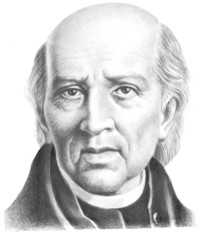Miguel Hidalgo y Costilla was a Mexican insurgent and priest. He was born on May 8, 1753 at the Hacienda de San Diego de Corralejo, Pénjamo, Guanajuato. He studied at the Colegio de San Nicolás, Valladolid (now Morelia), where he eventually became head of the school.
In 1778, he was ordained as a priest, and in 1803 he took charge of the Dolores parish, in Guanajuato. He concerned himself with bettering the living conditions of his parishioners, almost all of whom were indigenous people, teaching them to cultivate vineyards, keep bees, and manage small crockery and brick businesses.
In 1809, he joined forces with a secret society that had been formed in Valladolid, the purpose of which was to form a congress to govern New Spain in the name of King Fernando VII (imprisoned by Napoleon), and if possible, obtain independence for Mexico.
When the conspirators were discovered, the rebellion moved to Querétaro where Hidalgo met with Ignacio Allende. On September 16, 1810, carrying as a banner the Virgin of Guadalupe, Hidalgo uttered the cry of Dolores, which put the independence movement in motion. Accompanied by Allende, he managed to form an army made up of more than 40,000 people. They took Guanajuato and Guadalajara but decided not to occupy Mexico City.
On January 11, 1811, Hidalgo was defeated near Guadalajara by royal forces. He escaped and went north but was captured and sentenced to death. His head, together with that of Allende and those of other insurgents, was exhibited in the Granaditas market in Guanajuato to teach people a lesson.
After the establishment of the Mexican Republic in 1824, Hidalgo was recognized as the first insurgent and a founding father of Mexico. In his honor, one of Mexico's states and the city of Dolores were named after him. Mexico's independence day is celebrated on September 16, the day he proclaimed the insurgency.
